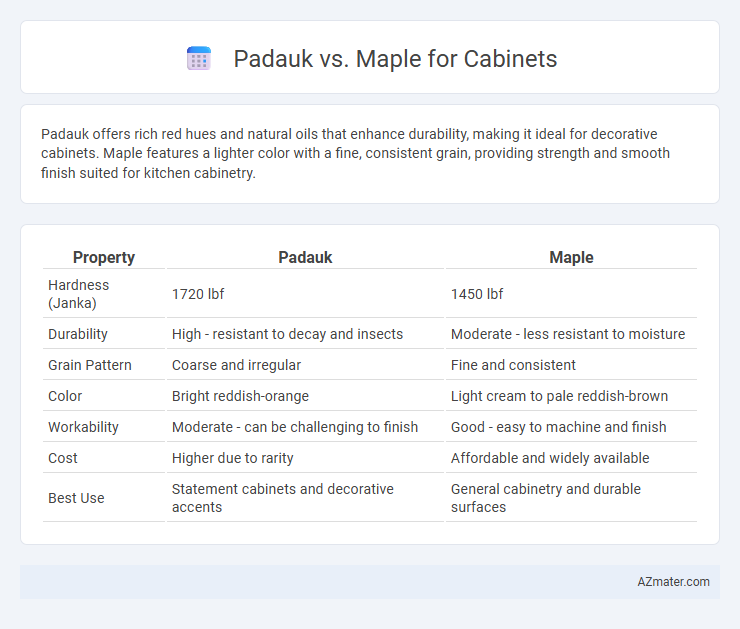Padauk offers rich red hues and natural oils that enhance durability, making it ideal for decorative cabinets. Maple features a lighter color with a fine, consistent grain, providing strength and smooth finish suited for kitchen cabinetry.
Table of Comparison
| Property | Padauk | Maple |
|---|---|---|
| Hardness (Janka) | 1720 lbf | 1450 lbf |
| Durability | High - resistant to decay and insects | Moderate - less resistant to moisture |
| Grain Pattern | Coarse and irregular | Fine and consistent |
| Color | Bright reddish-orange | Light cream to pale reddish-brown |
| Workability | Moderate - can be challenging to finish | Good - easy to machine and finish |
| Cost | Higher due to rarity | Affordable and widely available |
| Best Use | Statement cabinets and decorative accents | General cabinetry and durable surfaces |
Introduction to Padauk and Maple Woods
Padauk wood, known for its vibrant reddish-orange hue and exceptional durability, is prized in cabinet making for its resistance to wear and striking appearance. Maple wood features a fine, consistent grain with a pale cream to light reddish-brown color, offering a smooth finish and strong structural integrity ideal for cabinetry. Both woods provide unique aesthetic and functional benefits, with Padauk showcasing bold color and Maple delivering subtle elegance and toughness.
Key Differences Between Padauk and Maple
Padauk wood exhibits a vibrant reddish-orange hue and exceptional durability, making it ideal for striking, long-lasting cabinets, while Maple offers a lighter, creamy tone with a smooth grain, favored for a classic and versatile look. Padauk is dense and naturally resistant to decay and insects, providing superior strength compared to the softer, more workable Maple often chosen for intricate cabinetry details. Finishing Padauk requires careful sealing to prevent color darkening over time, whereas Maple takes stains and finishes evenly, allowing for a wide range of aesthetic options in cabinet design.
Appearance and Color Variations
Padauk wood exhibits a vibrant reddish-orange hue that deepens to a rich reddish-brown over time, offering bold and warm color variations ideal for striking cabinetry. Maple, known for its light creamy to pale reddish-brown shades, provides a more subtle and uniform appearance with fine, consistent grain patterns that complement both traditional and modern designs. The choice between Padauk and Maple hinges on whether a vivid, statement-making cabinet or a smooth, understated aesthetic is preferred.
Durability and Hardness Comparison
Padauk and Maple are both popular hardwoods for cabinets, but Padauk stands out for its superior durability and hardness. On the Janka hardness scale, Padauk rates around 1720, making it significantly harder and more resistant to dents and scratches than Maple, which typically measures between 950 to 1450 depending on the species. This exceptional hardness makes Padauk more suitable for high-traffic kitchen environments where wear resistance is crucial.
Workability and Machining Ease
Padauk wood offers excellent workability with its moderate hardness and smooth grain, allowing for easy cutting, shaping, and sanding in cabinet making. Maple, known for its dense and fine-grained texture, provides superior machining ease but requires sharper tools and slower feed rates to prevent burning or tear-out. Both woods perform well in cabinetry, but Padauk's natural oils can enhance machine tool longevity, while Maple's uniform structure ensures precise, clean cuts.
Finishing and Staining Qualities
Padauk wood showcases a vibrant reddish-orange hue that deepens over time, offering excellent stain absorption while maintaining its natural color brilliance without blotching. Maple features a smooth, fine grain with a pale cream color that takes stains evenly, allowing for a wide range of finishes but may require pre-treatment to avoid uneven absorption. Both woods respond well to finishing techniques, with Padauk providing a striking aesthetic for bold designs and Maple offering versatile options for classic, subdued cabinet styles.
Cost and Availability Factors
Padauk wood typically costs more than maple due to its exotic origin and limited supply, influencing budget considerations for cabinet projects. Maple, widely available in North America, offers a more affordable and consistent option with steady market supply. Evaluating cost-efficiency and material accessibility favors maple for large-scale or budget-conscious cabinetry, while padauk suits premium applications requiring distinctive reddish hues.
Environmental Impact and Sustainability
Padauk wood features a faster growth cycle compared to maple, reducing deforestation pressure and supporting more sustainable harvesting practices. Maple trees, often grown in managed North American forests, benefit from well-established reforestation programs that help maintain long-term ecosystem health. Both woods are durable for cabinetry, but choosing sustainably sourced Padauk or certified maple ensures minimal environmental impact and promotes responsible forest management.
Ideal Applications for Cabinets
Padauk wood, known for its rich reddish-orange hue and high density, is ideal for decorative cabinet fronts and high-end furniture requiring durability and striking color contrast. Maple offers a pale, uniform grain with exceptional hardness and resistance to wear, making it suitable for kitchen cabinets and areas exposed to daily use where a smooth finish and long-lasting surface are essential. Both woods provide excellent stability, but Padauk's unique color makes it preferable for statement pieces, while Maple's subtle elegance fits well in traditional and modern cabinetry.
Choosing the Best Wood for Your Cabinets
Padauk wood offers vibrant reddish hues and exceptional durability, making it ideal for bold, statement cabinets that resist wear and impact. Maple, known for its fine, consistent grain and light color, provides a smooth, uniform surface perfect for classic or modern cabinetry requiring ease of finishing and long-term stability. Choosing between Padauk and Maple hinges on your desired aesthetic and durability needs, with Padauk excelling in color richness and hardiness, while Maple delivers excellent workability and a timeless look.

Infographic: Padauk vs Maple for Cabinet
 azmater.com
azmater.com